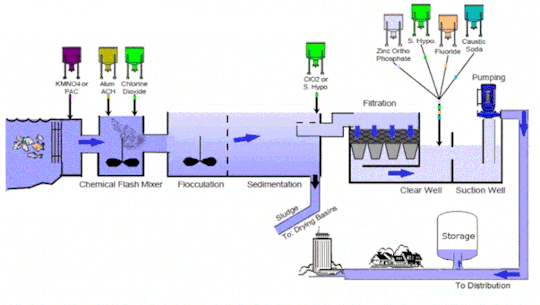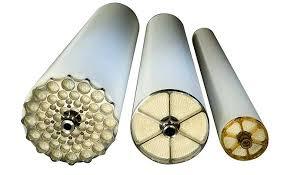#sustainable water filtration
Explore tagged Tumblr posts
Text
Ceramic Membrane Filtration: A Breakthrough in Water Treatment
Discover the power of ceramic membrane filtration in purifying water. Explore its applications in wastewater treatment, industrial processes, and more. Learn how ceramic membranes provide sustainable and efficient solutions with IPNR Endura.
#ceramic membrane filtration#ceramic water treatment#water purification technology#sustainable water filtration#ceramic membrane applications
0 notes
Text
From the article:
The two students presented their groundbreaking project at the 2024 International Science and Engineering Fair (ISEF); a device that operates by using ultrasound waves to push microplastic particles to one side of a water flow, allowing clean water to pass through while trapping the contaminants. In their tests, the system successfully captured up to 94 per cent of microplastic particles, showing promise for real-world applications. "If we could refine this, maybe use more professional equipment, maybe go to a lab instead of testing from our home, we could really improve our device and get it ready for large-scale manufacturing," Justin told Business Insider. The duo envisioned their device being used in water treatment plants, directly modifying the quality of water for daily use. This application could significantly reduce the amount of microplastics that end up in water sources, protecting ecosystems and human health.
#microplastics#water filtration#plastics#plastic pollution#pollution#good news#environment#sustainability#hope#hopepunk#ecology#water conservation
2K notes
·
View notes
Text
Dreame: Revolutionizing Smart Home with Vacuum Water Technology
The smart home industry is rapidly evolving, and brands like Dreame are leading the way with innovative solutions that enhance our daily lives. One of the standout features of Dreame's products is their integration of vacuum water technology, which not only simplifies cleaning but also contributes to a healthier living environment.
Dreame's vacuum water systems are designed to efficiently remove dirt and allergens from your home, ensuring that every corner is spotless. This technology works by combining powerful suction with advanced water filtration, capturing even the smallest particles and providing a deep clean that traditional vacuum cleaners often miss.
What sets Dreame apart is their commitment to user-friendly design. Their smart vacuums can be controlled via a mobile app, allowing you to schedule cleanings, monitor performance, and even receive real-time updates on your cleaning progress. This seamless integration of technology makes maintaining a clean home easier and more efficient than ever.
Additionally, the eco-friendly aspect of vacuum water technology promotes sustainability. By reducing the need for disposable cleaning supplies and utilizing water as a cleaning agent, Dreame is helping to minimize environmental impact while delivering exceptional cleaning results.
Overall, Dreame's innovative approach to smart home cleaning is a game-changer. With their vacuum water technology, you can enjoy a cleaner, healthier home without compromising on convenience or sustainability. I would love to hear about your experiences with smart home cleaning solutions and how they have transformed your daily routines!
0 notes
Text
Deep Dive into Primem Membrane Bioreactor Solutions

Water treatment is evolving fast, and Membrane Bioreactor (MBR) technology is leading the charge. Interested in knowing the factors that make MBR systems efficient? Or maybe you’re searching for the best MBR membranes for your next project?
Now, it is time to take a closer look at Primem membrane manufacturing and some of the reasons why they are excellent.
What is a Membrane Bioreactor (MBR)?
A Membrane Bioreactor, or MBR, is a smart wastewater treatment system. It combines biochemical activities with membrane filtration as a method of water purification. MBR on the other hand employs submerged membranes that filter out the impurities and produce water that is as clear as glass.
This makes it ideal for use in water treatment of wastewaters, industrial applications, and even preparation of drinking water.
However, there is a catch: the membrane’s quality determines the functionality of the system. That’s why choosing the best MBR membranes matters—and Primem delivers.
Meet Primem: A Leader in Membrane Solutions
Primem membrane is a company that is based in Singapore, and it has been in the process of manufacturing membranes for over 13 years. They mainly deal with PVDF hollow fiber membranes which are ideal for challenging water treatment applications.
Out of all the teams, the one of Primem is the most impressive, especially Dr. Jiang with almost 20 years of experience.
Their plant is ISO 9001:2015 certified and they have 16 patents for their products. It is because their membranes are recognized globally; they are found in Malaysia, South Africa. Wondering what makes them special? Let’s explore their offerings.
Primem Submerged Membrane Modules Unveiled
Submerged Membrane Modules, also called MBR membranes, are the core of any Best Membrane Bioreactor system. Primem provides a number of solutions based on the requirements of a client. Here is the list of their standardized modules:
SSM10R: Compact with a 10 m² area, great for small setups.
SSM20H: Offers 20 m², ideal for medium projects.
DSM35H: It is a powerful model with a cross section of 35 m² ideal for large applications.
It has two varieties; reinforced (R) and homogeneous (H) for versatility in use. Need something unique? Primem also provides non-standardized modules. They tweak dimensions to match your exact requirements, ensuring you get the best MBR membranes for your system.
Where Primem Membranes Make a Difference
Primem Membrane Bioreactor solutions shine in real-world scenarios. Here are some examples:
Palm Oil Challenges: One of the major challenges facing palm oil mill in Malaysia is how to treat the waste produced? In the process of filtration, Primem membranes cleared the mess and provided a clean bill.
Water Reclamation: In Singapore, they assist the process of converting sewage into valuable resources. It is a boon for the water-deficit regions of the world.
Safe Drinking Water: Their high filtration power leads to production of potable water hence enabling healthy community.
These cases show why Primem MBR membranes are among the best MBR membranes out there.
Why Primem Offers the Best MBR Membranes
What sets Primem apart in the Membrane Bioreactor world? Here’s the breakdown:
Rugged Construction: They are made from PVDF and their membranes are chemical resistant and durable.
Performance Excellence: They sieve out solids and anything that is impure like no one’s business.
Good value: quality is affordable and does not have to be expensive to be of good quality.
Custom: It is always possible to get the right fit for the individual in every occasion.
Looking for the best MBR membranes? Primem checks all the boxes.
Wrapping Up: Why Primem Wins
Primem will offer experience, quality, and customization to the table. Their Membrane Bioreactor systems and best MBR membranes tackle wastewater treatment with ease. Whether one needs a standard module or a completely unique design, they offer both.
Are you interested in improving the quality of water that is supplied in your area or homeowners association? For further information, please visit Primem About Page.
Have you used MBR membranes before? Leave your comments in the comments section or simply reach out to us to find out more on how Primetec may be of assistance to your subsequent project. Let’s keep the conversation flowing!
#Best MBR membranes#MBR membrane manufacturers#Membrane Bioreactor#wastewater treatment#PVDF membranes#Primem MBR#submerged membrane modules#water filtration#industrial water treatment#sustainable water solutions
0 notes
Text
Exploring the Benefits of Glacierfresh 4204490 Water Filter
The household water treatment equipment industry is thriving, and one standout brand making waves is Glacierfresh. Known for its commitment to quality and innovation, Glacierfresh offers top-notch solutions for clean and safe drinking water.
One of their flagship products, the Glacierfresh water filter, has gained popularity among consumers for its exceptional filtration capabilities. This filter is designed to remove impurities and contaminants, ensuring that the water you and your family consume is of the highest quality. With its easy installation and maintenance, the Glacierfresh water filter is a practical choice for households looking to improve their water quality.
Moreover, Glacierfresh emphasizes sustainability, using eco-friendly materials in their products. This not only helps in providing clean water but also contributes positively to the environment.
In conclusion, if you're in the market for reliable and effective water treatment solutions, consider Glacierfresh and their impressive water filter. Your health and well-being deserve nothing less!
#water quality#health and well-being#eco-friendly#household water treatment#sustainability#filtration capabilities
0 notes
Text
𝐔𝐥𝐭𝐫𝐚𝐟𝐢𝐥𝐭𝐫𝐚𝐭𝐢𝐨𝐧 𝐏𝐥𝐚𝐧𝐭 (𝐔𝐅 𝐏𝐥𝐚𝐧𝐭)
LARCO India Pvt Ltd. provides sophisticated Ultrafiltration Plant systems to improve water quality. With advanced filtration, energy efficiency, and space-saving design, we provide clean, dependable water for everybody.

#ultrafiltration#water filtration#industrial waste#waste water management#water recycling#water treatment plant#sustainability
1 note
·
View note
Text
Key Applications of an IoT-Based Pump Monitoring System: Driving Sustainability with ePropelled Motors
Industries worldwide are integrating Internet of Things IoT) technology into pump monitoring systems to enhance efficiency and sustainability. Pumps, essential for industries like water treatment and oil and gas, are now smarter and more efficient with IoT integration. At ePropelled, we lead this transformation with sustainable motors that complement IoT-based monitoring systems.
Understanding IoT-Based Pump Monitoring Systems An IoT-based pump monitoring system uses sensors and analytics to monitor parameters like flow rate, pressure, vibration, temperature, and energy use. Operators gain real-time insights via cloud platforms, enabling predictive maintenance, energy efficiency, and enhanced reliability—all critical for achieving sustainability goals.
Key Applications of IoT-Based Pump Monitoring Systems
Water and Wastewater Management Efficient water management is vital for addressing global challenges. IoT-enabled monitoring ensures pumps in water distribution and wastewater plants operate optimally, reducing energy waste, detecting leaks, and preventing breakdowns. ePropelled’s motors amplify these benefits by cutting power consumption and lowering carbon footprints.
Oil and Gas Industry In extreme conditions, inefficiencies in pump systems can lead to financial and environmental costs. IoT monitoring tracks performance metrics, detecting issues early. With ePropelled’s sustainable motors, operators ensure safe, eco-friendly operations.
Agriculture and Irrigation IoT-enabled monitoring delivers precise water usage, conserving resources and reducing waste. ePropelled’s energy-efficient motors lower operational costs and support sustainable farming.
HVAC Systems IoT-based monitoring optimizes pumps in heating, ventilation, and air conditioning systems. ePropelled’s motors align with green initiatives by improving energy efficiency.
Renewable Energy Systems IoT systems optimize pumps in solar and wind energy setups, enhancing efficiency and minimizing environmental impact. ePropelled motors ensure peak performance and sustainability.
The ePropelled Advantage Our advanced motors reduce energy consumption, extend equipment lifespan, and support global sustainability goals. Combined with IoT-based monitoring, they: · Reduce downtime via predictive maintenance · Minimize energy usage and costs · Prevent wear and tear · Lower carbon emissions
Conclusion IoT-based pump monitoring systems, paired with ePropelled’s motors, deliver smarter, greener operations. Connect with us to revolutionize your pump systems and drive a sustainable future.
#pool pump and filter#electric water pump#submersible water pump#pool pump motor#swimming pool pump motor#swimming pool pump and filter#swimming pool filtration pump#pool pump#sustainable pump motors
0 notes
Text
Discover how DGS (Drygen Glass Sand) revolutionizes water purification by reducing chemical use. Learn practical steps for cleaner, eco-friendly water solutions.
0 notes
Text
Exploring the Hollow Fiber Ultrafiltration Market: Trends, Forecasts, and Future Opportunities

In today’s water-conscious world, the Hollow Fiber Ultrafiltration (UF) market is rapidly expanding as industries and municipalities seek effective methods to purify water and treat wastewater. This article explores the latest market dynamics, including growth projections, emerging trends, and the global outlook for hollow fiber UF systems.
Understanding Hollow Fiber Ultrafiltration
Hollow Fiber Ultrafiltration technology relies on membranes designed with narrow, tubular fibers to filter out impurities from water and other liquids. These ultrafiltration systems excel at capturing fine particles, bacteria, and pathogens, making them essential for industries requiring high-quality water. UF technology is recognized for its efficiency and cost-effectiveness, particularly in sectors where water purity is critical. With tightening global regulations around water treatment and sustainability, the demand for UF solutions is accelerating worldwide.
Market Forecast: Significant Growth on the Horizon
Hollow Fiber Ultrafiltration (UF) market size is projected to grow from USD 2.08 billion in 2024 to USD 4.21 billion by 2029, registering a CAGR of 15.2% during the forecast period. The primary factors propelling this growth include:
Rising awareness around sustainable water use.
Increased government regulations regarding wastewater management.
Industrial growth in developing regions, especially in Asia-Pacific.
With these dynamics in place, North America, Europe, and Asia-Pacific will likely see strong market contributions. The Asia-Pacific region, in particular, is expected to register the highest growth, driven by rapid urbanization, water infrastructure investment, and stringent government regulations. North America and Europe will continue to see steady growth, primarily supported by established water infrastructure and advanced industrial activities.
Key Trends Influencing the Hollow Fiber UF Market
Growing Emphasis on Water Conservation and ReuseWater scarcity issues and increasing environmental awareness are pushing industries to adopt sustainable water management practices. Hollow fiber UF systems play a crucial role in recycling wastewater, reducing reliance on freshwater resources. Governments across the globe are introducing strict environmental standards, particularly in regions like the EU and Asia, which are known for implementing rigorous wastewater policies.
Technological Advancements in Filtration MembranesResearch into new materials and nanotechnology has led to notable improvements in filtration membranes. Modern hollow fiber UF membranes are more resistant to fouling and provide higher filtration precision. Innovations in membrane composition not only extend the product lifespan but also enhance system efficiency, especially beneficial for industrial applications with complex contaminants.
Industrial and Municipal DemandUF systems are gaining traction across several industries, notably pharmaceuticals, food and beverage, and petrochemicals. The ability of hollow fiber UF technology to handle high-contaminant loads makes it ideal for industrial wastewater treatment. Meanwhile, municipal governments are increasingly turning to UF systems for large-scale purification of drinking water.
Combination Filtration TechnologiesMany manufacturers are integrating UF systems with technologies like reverse osmosis (RO) and nanofiltration (NF) for comprehensive water treatment solutions. These hybrid systems enhance purification capabilities while minimizing energy and maintenance costs. The trend toward multi-stage filtration aligns with the demands of high-precision applications, such as in healthcare and advanced manufacturing sectors.
Market Landscape and Leading Companies
The Hollow Fiber Ultrafiltration market includes numerous players, both global and regional, that are competing to capture market share. Key players in this space include:
Pentair
DuPont
Asahi Kasei Corporation
SUEZ
Toray Industries, Inc.
These companies are heavily invested in innovation, with significant efforts devoted to developing high-performance, low-maintenance ultrafiltration systems. Their focus on expanding UF system portfolios reflects an understanding of the growing need for cost-effective, reliable water treatment solutions.
Insights from Industry Experts
Experts highlight that as environmental concerns escalate, demand for UF technology will only continue to rise. Hollow fiber ultrafiltration systems, known for their efficiency and cost savings, are gaining traction as industries worldwide focus on minimizing their ecological footprint. As per industry leaders, the heightened global emphasis on water quality is expected to drive the market forward, especially in regions facing severe water scarcity. Additionally, the increased adoption of hollow fiber UF for applications such as desalination and medical water purification reflects the market’s growing versatility.
Global Outlook for Hollow Fiber UF
The global market outlook for Hollow Fiber Ultrafiltration remains optimistic, with robust growth anticipated across various sectors. North America and Europe will likely retain their market position, given their well-developed infrastructure and consistent focus on industrial sustainability. The Asia-Pacific region, however, stands out as a high-growth area due to rapid industrialization and significant government investments in clean water initiatives.
Emerging markets in Latin America and Africa are also set to contribute to market expansion, driven by improving infrastructure and a heightened need for water management. Water-stressed areas, in particular, are exploring hollow fiber UF technology as a sustainable option to address water scarcity and ensure access to clean water.
Download PDF Brochure :
The Hollow Fiber Ultrafiltration market is entering a period of significant expansion as demand for water treatment solutions increases. Trends like environmental sustainability, membrane technology advancements, and hybrid filtration systems point to a promising future for UF technology. As more industries and municipalities prioritize water conservation, hollow fiber UF systems are set to play a critical role in achieving these sustainability goals.
The growing global need for clean, accessible water highlights the essential role of ultrafiltration in modern water treatment. By staying innovative and responsive to environmental needs, companies in the Hollow Fiber UF market can expect substantial growth and a long-term place in global water management.
#Hollow Fiber Ultrafiltration#Water Treatment Technology#UF Market Trends#Industrial Water Filtration#Ultrafiltration Membranes#Global Water Sustainability#Wastewater Management Solutions
0 notes
Text
Welcome to AquaCubed - Your Go -To Source for Water Filtration Insights
Dive into AquaCubed’s blog, your ultimate resource for everything related to water filtration! Our mission is to empower homeowners with the knowledge they need to make informed decisions about their water quality. From understanding the importance of whole house water filtration systems to expert tips on maintenance and installation, our blog covers a wide range of topics to ensure you and your family enjoy clean, safe water. Explore our latest articles that delve into the benefits of various filtration technologies, common water contaminants, and solutions tailored to your needs. Join us on this journey to better water quality and discover how AquaCubed can enhance your home's water experience!
AquaCubed #WaterFiltration #CleanWater #HomeImprovement #HealthyLiving #WaterQuality #FiltrationSystems #SustainableLiving #HomeownerTips #WaterSafety
#Aqua-Cubed#Water-Filtration#Clean-Water#Home-Improvement#Healthy-Living#Water-Quality#Filtration-Systems#Sustainable-Living
0 notes
Text
Water Treatment Technology Market Report - Forecast (2024–2030)
Water Treatment Technology Market size is estimated to reach US$82.7 billion by 2030, growing at a CAGR of 5.2% during the forecast period 2024–2030. Stringent regulations and Growing industrialization are expected to propel the growth of Water Treatment Technology Market.
The shift towards decreased groundwater pumping reflects a growing awareness of the importance of sustainable water management practices. Instead of solely relying on groundwater sources, industries and municipalities are increasingly investing in water treatment technologies to utilize alternative water sources such as surface water, reclaimed wastewater, and desalinated seawater. Another one is the focus on infrastructure improvements in water treatment systems. Aging infrastructure, coupled with increasing water demand, has led to investments in upgrading and modernizing water treatment facilities. This includes the adoption of advanced treatment technologies, automation, and digitalization to enhance the efficiency, reliability, and resilience of water treatment processes. These trends are shaping the market growth in the water treatment Technology.
Sample Report:
Water treatment technology is an essential line of defense to eliminate bacteria and contaminants before the supply of potable and #clean water for consumption. It includes several stages such as collection, screening & straining, #chemical addition, coagulation & flocculation, sedimentation & clarification, filtration, disinfection, storage, and distribution
Market Growth and Trends:
Driven by the rising incidence of cancer, increasing investments in biotechnology, and advancements in gene-editing technologies, the global Engineered T Cells Market is projected to grow exponentially in the coming years. According to market analysts, the market is expected to expand at a compound annual growth rate (CAGR) of 30–35% over the next decade, with North America currently leading in terms of both market share and innovation. The growing interest in cell-based therapies, particularly in oncology, is further propelling this growth.
Inquiry Before:
Key factors influencing the market include:
Advances in Gene-Editing Technologies: The development of tools such as CRISPR and other gene-editing platforms have accelerated the creation of more precise and efficient T cell therapies.
Regulatory Approvals: In recent years, therapies like Kymriah and Yescarta have gained FDA approval, setting the stage for a wave of new products.
Partnerships and Collaborations: Pharmaceutical companies are forming strategic alliances with biotechnology firms to co-develop innovative engineered T cell therapies.

Challenges and Opportunities
While the potential for engineered T cells is vast, there are several challenges that must be addressed. These include:
High Cost of Treatment: Current therapies can cost up to $500,000 per patient, creating a barrier for widespread adoption.
Safety and Efficacy: Concerns remain over side effects like cytokine release syndrome (CRS) and the long-term durability of T cell responses.
Manufacturing Complexities: The production process for engineered T cells is time-consuming and complex, which may limit scalability.
Schedule a Call:
Competitive Landscape
Major players in the Engineered T Cells Market include:
Novartis (Kymriah)
Gilead Sciences (Yescarta)
Bristol-Myers Squibb (Breyanzi)
Bluebird Bio
Autolus Therapeutics
The Future of Engineered T Cell Therapy:
Looking forward, the potential of engineered T cells extends beyond oncology. Research is underway to explore the use of these therapies in autoimmune diseases, infectious diseases, and even some neurological conditions. As the science evolves, it’s clear that the Engineered T Cells Market will remain at the forefront of cutting-edge biotechnology, offering new hope to millions of patients worldwide.
Conclusion
The engineered T cells market is on the cusp of tremendous growth, fueled by technological advancements and the urgent need for more effective treatments in oncology and other disease areas. Companies investing in this space are not only pushing the boundaries of what is possible in immunotherapy but are also setting the stage for a future where personalized medicine becomes the norm. The next few years will be crucial in shaping the market as more therapies move from clinical trials to commercial success.
Buy Now:
Innovations in Water Treatment Technology: Paving the Way for a Sustainable Future
As the global population grows and industrial activities expand, the demand for clean and safe water has never been greater. Water treatment technology plays a critical role in ensuring that water resources are purified and made safe for consumption, industrial use, and environmental protection. With increasing concerns about water scarcity, pollution, and environmental sustainability, the water treatment industry is undergoing rapid innovation to address these challenges.
Key Advancements in Water Treatment Technology
Membrane Filtration Technologies:
Reverse Osmosis (RO) and Nanofiltration (NF) membranes are widely used to remove salts, contaminants, and even microscopic pollutants like bacteria and viruses. These systems are highly efficient and are essential for desalination, turning seawater into drinkable water.
Ultrafiltration (UF) and Microfiltration (MF) systems, using porous membranes, are increasingly employed in municipal and industrial wastewater treatment to filter out particulate matter.
Advanced Oxidation Processes (AOPs):
AOPs are chemical processes that involve highly reactive species like hydroxyl radicals to break down and eliminate harmful organic pollutants. These methods, including ozonation and UV/Hydrogen Peroxide, are used in treating industrial wastewater, pharmaceuticals, and removing emerging contaminants like PFAS (per- and polyfluoroalkyl substances).
Biological Treatment Technologies:
In bioreactors, microorganisms are harnessed to degrade organic contaminants in wastewater, making it suitable for reuse or safe discharge. Technologies like Membrane Bioreactors (MBR) and Moving Bed Biofilm Reactors (MBBR) are revolutionizing biological wastewater treatment, offering higher efficiency in smaller, more compact systems.
Electrochemical Water Treatment:
This technology uses electrical currents to drive chemical reactions that purify water. Electrocoagulation, electrodialysis, and capacitive deionization (CDI) are effective in removing dissolved solids, heavy metals, and other pollutants, making them particularly useful in industrial water treatment.
Smart Water Systems & IoT:
The integration of IoT (Internet of Things) and data analytics is transforming the water treatment landscape. Smart sensors and remote monitoring tools now allow real-time tracking of water quality, system performance, and early detection of problems. This technology enables more efficient operation and maintenance of water treatment plants, reducing costs and improving water management.
Addressing Global Challenges
1. Water Scarcity:
With water scarcity affecting millions worldwide, desalination technologies are gaining traction. Desalination plants, powered by energy-efficient reverse osmosis systems, are being deployed in water-stressed regions to transform seawater into potable water. The development of energy-efficient desalination membranes is also making this process more sustainable.
2. Wastewater Reuse:
Industrial processes generate vast amounts of wastewater, which can be treated and reused through Zero Liquid Discharge (ZLD) systems and other advanced water recycling technologies. Recycled wastewater is increasingly being used in agriculture, industrial cooling, and even for non-potable domestic purposes, significantly reducing water demand.
3. Contaminant Removal:
Emerging contaminants such as microplastics, pharmaceuticals, and PFAS are becoming major environmental and health concerns. Technologies like activated carbon filtration, advanced membrane systems, and AOPs are being developed and enhanced to effectively capture and remove these contaminants from both drinking water and wastewater.
Future Trends in Water Treatment
Decentralized Water Treatment:
Decentralized, small-scale water treatment systems are becoming more popular in remote areas, developing countries, and industrial settings. These systems provide localized water treatment solutions that can be customized to specific needs and avoid the high costs of centralized infrastructure.
Green Water Treatment Technologies:
Sustainability is driving the development of eco-friendly water treatment technologies. Innovations such as solar desalination, wetland-based water treatment, and biodegradable filters are gaining attention for their low energy consumption and minimal environmental impact.
Artificial Intelligence (AI) and Machine Learning:
AI and machine learning are being employed to optimize water treatment processes, predict equipment failures, and improve water quality monitoring. These technologies enable real-time decision-making, enhancing the efficiency and reliability of water treatment systems.
Conclusion: The Future of Water Treatment Technology
The water treatment sector is evolving rapidly, fueled by the growing demand for clean water and environmental protection. From cutting-edge membrane technologies to smart water systems and sustainable treatment methods, the innovations in this space promise to address pressing global water challenges. As new contaminants emerge and climate change exacerbates water scarcity, continued investment in water treatment technology will be crucial for ensuring a secure and sustainable water future for all.
For more about Water treatment techology click here
0 notes
Text
Strengthen Your Immune System with the Gentoo Glass Water Filter Jug

A robust immune system is essential for maintaining overall health, providing protection against a wide array of illnesses and diseases. A critical yet often undervalued factor influencing immune health is proper hydration. Ensuring adequate water intake is crucial for supporting various aspects of immune function, and incorporating the Gentoo Glass Water Filter Jug into your daily routine can help achieve optimal hydration, ultimately contributing to a stronger immune system.
In this article, we will delve into the impact of hydration on immune function, discussing how proper hydration promotes toxin removal, supports the production and circulation of immune cells, and maintains mucosal integrity. We will also explore the unique benefits of consuming purified water, such as that provided by the Gentoo Glass Water Filter Jug, in supporting immune health. By understanding the role of hydration in immune function and embracing the use of the Gentoo Glass Water Filter Jug for your daily water intake, you can effectively strengthen your immune system and enjoy the benefits of improved overall health.
Furthermore, we will provide practical tips for incorporating the Gentoo Glass Water Filter Jug into your daily routine to ensure optimal hydration and immune system support. Lastly, we will discuss additional immune-boosting strategies and lifestyle habits that can further contribute to a stronger, more resilient immune system, highlighting the central role of maintaining proper hydration with the Gentoo Glass Water Filter Jug.
Strengthening Your Immune System through Hydration and the Gentoo Glass Water Filter Jug

A Well-Hydrated Immune System: The Key to Optimal Health
Maintaining proper hydration has a significant impact on immune function, ensuring that our body's natural defences operate at peak efficiency. By consuming an adequate amount of water daily, we can support various aspects of our immune system, enhancing our body's ability to ward off illness and disease. Key benefits of hydration on immune function include:
Toxin Removal: Water plays a crucial role in waste removal, helping to flush toxins from the body and ensuring that harmful substances are not retained. This function assists in reducing the workload of the immune system, allowing it to focus on fighting off infections and other threats.
Immune Cell Production and Circulation: Staying hydrated aids in the production and circulation of immune cells, such as lymphocytes, which play a vital role in maintaining a healthy immune system. By keeping our cells hydrated, we facilitate their efficient transportation throughout the body, improving our body's ability to address and combat health threats.
Mucosal Integrity: Our mucous membranes act as the first line of defence against pathogens. Proper hydration helps maintain these membranes' integrity, ensuring that they can effectively trap and neutralise harmful substances before entering the body.
Given the importance of hydration for immune function, utilising tools such as the Gentoo Glass Water Filter Jug can help you stay optimally hydrated and support a robust immune system.

Filtered Water: A Source of Immune Boosting Power
The Gentoo Glass Water Filter Jug provides a source of purified water that offers several advantages for supporting immune health. The advanced filtration technology used in the Gentoo jug removes a variety of contaminants, such as chlorine, heavy metals, and other pollutants, from tap water. This ensures that the water you consume is not only better tasting but of the highest quality for your body.
Consuming purified water ensures that your body can effectively absorb the essential nutrients it requires for a healthy immune system. Proper hydration is crucial for the absorption of vitamins and minerals, playing a vital role in immune function. Moreover, filtered water is free of contaminants that may potentially compromise immune function, further enhancing the immune system's ability to protect the body from illness.
By incorporating the Gentoo Glass Water Filter Jug into your daily routine, you can ensure that you're consuming the purest water possible, ultimately contributing to a stronger immune system.

Maximising Immune Health with the Gentoo Glass Water Filter Jug
Incorporating the Gentoo Glass Water Filter Jug into your daily routine is a simple way to maintain optimal hydration and promote a healthy immune system. Here are some tips and suggestions for getting the most out of your Gentoo jug:
Keep It Accessible: Place your Gentoo Glass Water Filter Jug in a convenient, easy-to-reach location in your home or workplace, ensuring that you always have access to filtered water throughout the day.
Set a Daily Water Goal: Determine your daily water intake needs based on factors such as your body weight, activity level, and climate. Use the Gentoo Glass Water Filter Jug to measure your water intake, helping you stay on track to achieve your hydration goals.
Establish Habits: Create routines for consuming water at regular intervals, such as drinking a glass of filtered water first thing in the morning, with meals, and before bedtime. This will help you consistently maintain optimal hydration.

Wellspring of Health: Supplementing Your Hydration Efforts
In addition to maintaining proper hydration using the Gentoo Glass Water Filter Jug, adopting other immune-boosting lifestyle habits can further contribute to a healthy, resilient immune system. Some suggestions include:
Eat a Balanced Diet: Aim to consume a varied diet rich in fruits, vegetables, whole grains, lean proteins, and healthy fats to provide your body with the essential nutrients it requires for immune function.
Engage in Regular Exercise: Maintaining an active lifestyle can support immune health by promoting the circulation of immune cells and regulating the release of stress hormones, which can negatively impact immune function.
Prioritise Sleep: Ensure that you're getting adequate rest each night, as sleep plays a crucial role in immune function, with a lack of sleep potentially increasing the risk of illness.
Manage Stress: Implement stress management techniques, such as meditation, deep breathing exercises, or engaging in hobbies, to minimise the impact of stress on your immune system.

Conclusion
Proper hydration is essential for a strong, well-functioning immune system. The Gentoo Glass Water Filter Jug offers a simple, effective means of maintaining optimal hydration, ultimately contributing to enhanced immune health. By recognising the importance of hydration for immune function and utilising the Gentoo jug for purified water intake, you can effectively bolster your immune system and enjoy the benefits of improved overall health. Implement the tips and strategies in this article to support your hydration efforts further, paving the way for a more resilient immune system and healthier life.
READ MORE >>
#Immunity Health#Hydration#Water Filtration#Gentoo Glass#Healthy Living#Wellness#Clean Water#Eco Friendly#Sustainable Living#Alkaline Water#Detox#Toxin Free#Healthy Habits#Self Care#Natural Wellness#Holistic Health#Stay Hydrated#Wellness Journey#Boost Immunity#Healthy Choices#Mindful Living#Wellbeing#Health Tips#Immune Support#Filter Water#Clean Living#Healthy Lifestyle#Wellness Tips#Natural Health#Immune Boosting
0 notes
Text
#wetlands#ecosystem#biodiversity#habitat#conservation#environment#marshes#swamps#bogs#fens#mangroves#peatlands#floodplains#estuaries#water filtration#flood control#carbon sequestration#migratory birds#endangered species#Ramsar Convention#ecosystem services#climate change#pollution#deforestation#sustainable development
0 notes
Text
Breaking Down the Mechanics of Pressurized Membrane Modules

Pressurized membrane modules serve as a fundamental technology for processing water and food products while supporting pharmaceutical development alongside various industrial production processes. Membrane modules represent one of several membrane system types that lead to current industrial adoption among multiple organizational applications.
Hydraulic pressure functions in these systems to pull objects through semi-permeable barriers so that the modules can execute desired separations of essential materials from undesirable ingredients. A detailed study of pressurized membrane modules explores their operational mechanism and their benefits alongside their current and projected uses.
1. Working Principle of Pressurized Membrane Modules
Pressurized modules push liquid by using external pressure to pass fluids through permeable membranes featuring tiny pores that block the passage of particles microorganisms and other impurities. Membrane systems operate with pressurized units to carry out filtration techniques including RO (Reverse Osmosis) while also providing UF (Ultrafiltration) MF (Microfiltration) and NF (Nanofiltration). The basic operation involves the following steps:
Feed Water Input: Each module accepts a feed solution that can consist of either pure water or various liquid mixtures.
Pressure Application: An external pressure difference applies to the membrane. The system design determines which mechanism such as pumps will create this pressure.
Separation Process: Membrane pressure pushes liquids from one side while letting molecules with smaller dimensions pass forward while trapping other particles so they collect on the opposite side.
Permeate and Concentrate Streams: The membrane separates liquid into two components - permeate exists as the clear passing solution and the retained substances become concentrated or retentate.
Membrane module operation based on pressure reaches its performance through management of pre-applied pressures that differ according to filtration types. Port de pressure levels differ between membrane filtration techniques where reverse osmosis demands high pressure but ultrafiltration and microfiltration function with lower pressures.
2. Design and Structure
The design of the quality membranes modules is an integral part of their efficiency and performance. There are a number of structural features that make the filtration process optimal for several applications.
Membrane Configuration: Membranes are configured in various forms according to the type of filtration. Common configurations include spiral wounds, hollow fiber, flat sheets, and tubular membranes.
Spiral Wound Membranes: These are the most common form of membrane arrangement used in pressurized modules. They have membrane sheets wrapped around a central core. They provide a very high surface area in a very compact form and are, therefore, very efficient.
Hollow Fiber Membranes: The membranes are essentially tiny fibers through which the liquid flows. These are usually employed for applications where high flux rates are required, such as desalination of water.
Tubular Membranes. These are composed of rigid tubes and can accommodate highly viscous fluids; it is often more industrial and commercial in applications.
Pressure Vessel and Housing: The housing structure contains the membrane and maintains the structural integrity in addition to ensuring protection from damaging elements while under operation. In addition, such vessels can hold up to highly elevated operating pressures to maintain long-term service.
Flow Path Configuration: The flow path in these modules is designed so that the filtering efficiency is achieved at its optimum. The feed flow can either be cross-flow or dead-end flow, arranged according to what the system calls for.
3. Applications of Pressurized Membrane Modules
These quality membranes modules can be applied in a wide variety of industrial applications due to their versatility. Their main use is to separate or concentrate material, and thus they are very significant in applications where high purity and specific separations are concerned.
Water Treatment: Primemtec’s pressurized membrane modules are widely used in municipal and industrial water treatment systems. Reverse osmosis membranes, in particular, are critical for desalinating seawater, treating brackish water, and purifying drinking water.
Food and Beverages: Pressurized membranes in the food industry are used in juice concentration, processing of dairy like milk filtration, and production of beer. Ultra- and microfiltration membranes separate proteins and other dissolved constituents from liquids.
Pharmaceuticals and Biotech: These modules are essential for separating biological substances, sterilizing products, and concentrating active pharmaceutical ingredients (APIs). They ensure high product purity and consistency, which are critical in pharmaceutical production.
Chemical and Petrochemical Industries: Pressurized membranes module are used in chemical recovery, solvent recovery, and other processes where the separation of complex mixtures is required. They help in reducing energy consumption and enhancing operational efficiency.
Wastewater Treatment: The membrane modules in wastewater treatment plants are used at both the filtration and treatment stages to remove contaminants from effluent streams. It ensures that treated water meets specified quality standards for compliance with environmental regulations.
Summary
Primemtec’s pressurized membrane modules stand as fundamental components of modern filtration science which deliver flexible efficient scalable industrial solutions throughout multiple domains. Through pressure-driven system operations, these technologies enable both liquid separation and purification which drives advances across water treatment alongside food processing and pharmaceutical production and multiple other vital industrial sectors. The future of sustainable and efficient filtration technology will become possible thanks to new membrane materials and system design innovations that overcome operational costs and fouling challenges.
#Pressurized membrane modules#filtration technology#reverse osmosis membranes#ultrafiltration membranes#microfiltration membranes#nanofiltration membranes#membrane system#water treatment#desalination#food and beverage filtration#pharmaceutical filtration#chemical separation#wastewater treatment#spiral wound membranes#hollow fiber membranes#tubular membranes#pressure vessel#membrane housing#industrial water purification#liquid separation#sustainable filtration technology#high-efficiency filtration#membrane fouling prevention#biotech filtration#solvent recovery#advanced membrane materials#scalable filtration solutions#energy-efficient filtration#Primemtec membrane modules#industrial filtration systems
1 note
·
View note
Text
Water for All: India's Mission with Treatment Companies
In the vast expanse of India, water is not just a resource; it's a lifeline, a symbol of vitality, and a cornerstone of civilization. Yet, amidst its abundance, lies a stark reality - millions of people across the nation struggle to access clean and safe water. This is where India's water treatment companies step in, not merely as entities driven by profit but as guardians of public health and environmental stewardship.
Our Commitment to Accessible Water
Ensuring Equitable Distribution
In our mission to provide water for all, we recognize the need for equitable distribution. We understand that access to clean water should not be a privilege but a fundamental right. That's why we strive to reach every corner of India, from bustling metropolises to remote villages nestled in the hills, ensuring that no one is left behind.
Empowering Communities
We firmly believe that sustainable change begins at the grassroots level. Through community engagement and empowerment initiatives, we work hand in hand with local leaders and residents to identify needs and implement tailored solutions. By fostering a sense of ownership and responsibility, we empower communities to take charge of their water resources and build a brighter future for generations to come.
Innovating for Impact
Harnessing Technology for Good
Innovation lies at the heart of our efforts to expand access to clean water. From state-of-the-art purification systems to decentralized water treatment solutions, we leverage the latest technologies to maximize efficiency and effectiveness. By continuously pushing the boundaries of what's possible, we aim to set new standards for water treatment excellence in India and beyond.
Investing in Research and Development
To stay ahead of the curve, we understand the importance of investing in research and development. Through strategic partnerships with leading academic institutions and industry experts, we explore new avenues for improving water quality, optimizing resource utilization, and mitigating environmental impact. By fostering a culture of innovation and collaboration, we pave the way for groundbreaking discoveries and breakthrough solutions.
Sustainability at the Core
Balancing People, Planet, and Profit
As stewards of the environment, we recognize our responsibility to operate in a sustainable manner. We are committed to balancing the needs of people, the planet, and profit, ensuring that our actions have a positive impact on both society and the environment. From reducing energy consumption to minimizing waste generation, we integrate sustainability into every aspect of our operations, guided by the principles of corporate social responsibility and environmental stewardship.
Embracing Circular Economy Principles
In our quest for sustainability, we embrace the principles of the circular economy. We strive to minimize resource consumption, maximize resource efficiency, and promote the reuse and recycling of materials wherever possible. By closing the loop on water management, we aim to create a regenerative system that benefits both present and future generations.
Collaborating for Change
Building Strategic Partnerships
We recognize that no single entity can address the complex challenges of water management alone. That's why we actively seek out partnerships with governments, NGOs, academic institutions, and other stakeholders to leverage collective expertise and resources. By working together towards a common goal, we amplify our impact and drive meaningful change at scale.
Advocating for Policy Reform
In addition to our operational efforts, we are strong advocates for policy reform and legislative action to promote sustainable water management practices. We engage with policymakers and decision-makers to raise awareness about water-related issues, advocate for stronger regulations, and support initiatives that advance the cause of water conservation and access.
Conclusion: A Call to Action
As we look to the future, the mission to provide water for all remains as urgent and vital as ever. Together, we have the power to make a difference, to transform lives, and to safeguard the precious resource that sustains us all. Let us join hands, India's water treatment companies and stakeholders across society, in a shared commitment to ensuring that every individual has access to clean and safe water, today and for generations to come.
If You Want to Explore More About Water Treatment Companies In India then Visit the Site: Jasmino
#technology#watermanagement#safe drinking water#water treatment technology#water treatment#sustainable practices#filtration system
0 notes
Text
Aquarius Projects | Innovative Recycling and Recovery Systems
Aquarius Projects provides sustainable water treatment systems that optimize resource utilization, minimize waste & extract valuable materials from wastewater

#Aquarius Projects#Wastewater solutions#Recycling systems#Recovery systems#Water resource recovery#Wastewater recycling#Sustainable water solutions#Advanced filtration technology
0 notes